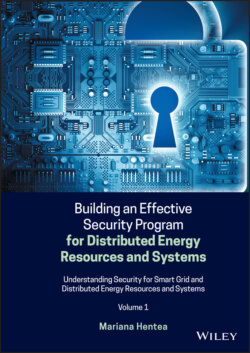Читать книгу Building an Effective Security Program for Distributed Energy Resources and Systems - Mariana Hentea - Страница 56
1.8.3.1 Key Players in Smart Grid Standards Development
ОглавлениеThe major key players involved in the development of standards supporting the Smart Grid include:
NIST – Private agency (former federal technology agency).
ISA – International organization of engineers in control of industrial processes.
SGIP (Smart Grid Interoperability Panel) – Different areas.
UCA International User Group – Suppliers of electric/gas/water utility systems.
GridWise Alliance – Transform the US electric grid to achieve a sustainable energy future.
EPRI/EEI – Research and innovation in many areas.
ZigBee Alliance – Low‐power radio inside buildings.
Wi‐Fi – Interoperability of wireless products.
IEEE P2030 – Standards and guidelines for Smart Grid applications.
IRENA – International renewable integration.
ISO – International standards; technology standards.
IEC – Active in many areas of the Smart Grid.
IETF – Internet standards in many areas of the Smart Grid.
ITU‐T – Active in many areas of the telecommunications and Smart Grid.
ANSI – Working on meters.
NAESB – North America industry interoperability standards for gas and electricity.
NEMA – Electrical equipment manufacturers.
NRECA – Electric cooperative utilities.
State legislatures.
Federal/state regulators.
FERC – US Federal Energy Regulatory Commission.
NERC – Reliability of US interconnected systems including portions of Canada and Mexico.
ITU‐T – Communications and many Smart Grid applications.
OASIS – Cross‐domain standards for services to enable machine‐based scheduling of human‐centric activities.
ASHRAE – HVAC and refrigeration standards.
IETF – Internet standards for the Smart Grid.
SAE – Communication between PEV and the electric power grid.
OpenADR Alliance – Standards for DR implementations.
Bacnet – Standards for commercial buildings and integration with the Smart Grid.
OPC – Standards for open connectivity of ICSs and process control.
One of the most important side benefits of the Smart Grid is the work being performed by government and industry groups in collaboration. Developing interoperability standards plays a key role in supporting grid modernization.
The work of the National Institute of Standards and Technology (NIST) and industry associations such as the International Electrotechnical Commission (IEC), the Electric Power Research Institute (EPRI), and the Smart Grid Interoperability Panel (SGIP) and trade groups like the GridWise Alliance (GWA) and GridWise Architecture Council (GWAC) all contribute to establishing the definitions and specifications for connecting grid devices. These groups have enabled rapid progress forward in the development of the Smart Grid. Processes are already in place to close the gaps in current standards. Most grid‐focused interoperability projects that adhere to the current standards can now move forward with a high degree of confidence. The most active of these groups include the GridWise Architecture Council and NIST’s SGIP.
